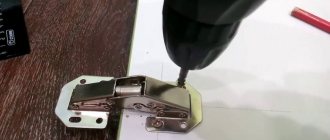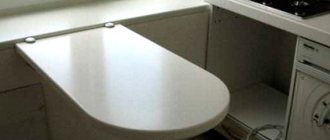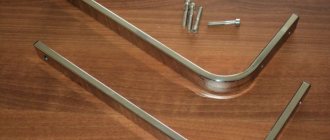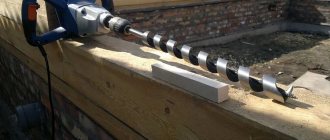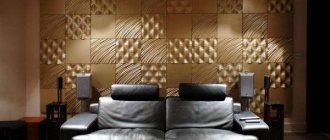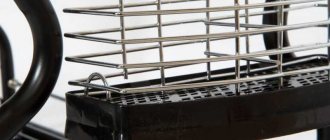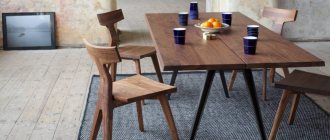Sometimes at home you need to make holes in blanks made of wood, metal, chipboard or other material.
And the presence of a screwdriver does not help and does not allow making holes strictly at an angle of 90, we are not talking about oblique holes at different angles.
To facilitate the processing of materials, a drilling jig is used.
These devices are widely used in the furniture industry.
[contents]
Design features and types of conductors
The drilling jig is actually a template of holes that allows you to make them with maximum accuracy. They can be divided into two types:
- when the drilling axis is at right angles to the surface of the material;
- when the axis passes at an acute or obtuse angle relative to the plane.
Conductor device
The tool has such versatility that it is used in various fields of industry. For several decades it has been very actively used in the engineering and construction industries. After all, it allows you not only to drill holes in the required workpieces at different angles and with excellent accuracy, having different configuration features. With its help, holes can be easily drilled in various building structures, as well as pipes made of any material, etc. The jig is often used in the furniture industry, as it greatly simplifies the process of fastening fittings and assembling its various parts. In fact, this is only a small range of tasks that a conductor can solve.
Application
Drilling jigs are used in many fields of activity. Most often in construction. But besides this, there are several other important industries.
Furniture
During assembly, many craftsmen are faced with a problem such as a lack of holes. In this case, you have to make new ones yourself. To do this easily, it is recommended to use a jig. With its help, all work will be done quickly, efficiently and accurately. Craftsmen who do not have a special machine should also resort to the help of such a device.
Modern assembly is distinguished by a wide selection of furniture fittings and various fasteners. All this requires precise installation without displacement. This is where the conductor will help.
Pipes
Making holes of the correct shape on cylindrical surfaces is quite difficult. Using a drill in this case is useless. It will constantly slide off, which means they will all turn out to be of irregular shape. For this, it is recommended to use a conductor.
Additionally, you can use devices that help make perpendicular holes. It will also help to process rounded elements and edges.
Classification of tools
Based on functionality and design functionality, drilling jigs are divided into types:
- invoices. The name comes from their functional way of working, that is, they are applied to the workpiece or the surface being processed, attached to it with special clamps or held by hand. This device is suitable for drilling flat surfaces, such as boards, MDF boards and chipboards. It is called a furniture jig for drilling holes. Thanks to the use of a jig, the holes themselves are very neat and precise;
- rotary. Such templates are ideal for drilling round or cylindrical surfaces. Thanks to this design, the axis occupies a horizontal, vertical and inclined position to the surface. This is possible thanks to bushings that can guide the drilling line;
- universal. Products of this design are widely popular in small industrial production, where quick adjustment to the existing surface plays an important role. Due to their uniqueness, they are also in demand in the household, when it is necessary to work with different materials, planes and surfaces; tipping. In terms of functionality they are somewhat reminiscent of universal ones. They are necessary when you need to make a hole in different planes and at different slopes. This is very convenient for carrying out some repair work when you need to drill a hole in the wall without a lot of time and at a specific angle;
- sliding. According to its name, such a conductor does not have to be attached to the surface where it is supposed to be applied. It should be noted that such a conductor is inconvenient to use, since it requires constant hand holding;
- fixed. Unlike sliding jigs, they are attached to the place where they are intended to be used. They are much easier to attach, but due to their design they limit the scope of human work. This can be clearly seen when working on walls or vertical planes with only one spindle.
Jig for drilling overhead holes
Universal drilling jig
Jig for drilling holes, fixed
Rotary hole drilling jig
Main types
Based on the type of design and functionality, devices used for adding (drilling) holes in elements of furniture structures may fall into one of the following categories.
Invoices
These are jigs that are applied to the surface of the workpiece and either fixed on it or held in a given position by hand. Using such a device for making furniture, holes are made in flat parts (for example, in slabs made of chipboard or MDF).
Rotary
The working bar of such conductors can rotate in both horizontal and vertical planes. Using this device, you can make holes in parts of complex geometric shapes. Such a jig is used for drilling holes whose axis is located at an angle.
Universal
These are reconfigurable jigs for making furniture. It is advisable to use devices of this type in production shops that produce furniture in small batches. The versatility of such jigs for furniture production lies in the fact that they can be quickly reconfigured to different combinations of the location of the holes being made.
Tiltable
Conductors of this type are used in cases where it is necessary to drill holes in several planes.
In addition, more highly specialized jig devices are actively used in furniture production (in particular, a dowel jig for assembling furniture and a device that makes it possible to accurately and efficiently make holes for confirmations).
Using a jig when drilling the end of furniture boards will protect you from accidental drift of the drill to the side and, as a result, damage to the workpiece
According to the method of fixation on the surface of the workpiece, jigs are divided into sliding and fixed type devices. Devices that are fixed to the part before processing, although more convenient to use, somewhat limit the freedom of action of the master. This is especially critical in cases where drilling is performed on a machine equipped with a single spindle mechanism.
Using a jig, it is possible to avoid a rather serious problem: the drill entering the surface of the workpiece at the wrong angle. Coping with this problem, if it has already arisen, is quite difficult, and in many cases simply impossible. When using a jig, the drill not only enters the material being processed at the required angle, but also does not deviate from the specified direction throughout the entire drilling process. You cannot do without a jig in cases where it is necessary to drill a hole at a certain angle in thin furniture boards made of chipboard or MDF.
Some drilling operations (for example, making oblique holes) simply cannot be done without special tools
Setting up the production of furniture with your own hands, if you use conductors in such production, is possible even for a person who is not highly qualified and does not have sufficient experience in this field. When using such devices, there is no need to perform complex preliminary calculations and mark out locations for future holes.
Scope of application
It should be noted that the drilling jig is used almost everywhere where there is a need to regularly drill holes. These areas could be:
- furniture manufacture. When making furniture, it is very often necessary to drill holes for fastening materials, fittings and accessories. The further appearance of the furniture, its presentability and marketability depend on the accuracy and correctness of the hole made;
- construction. When carrying out construction and repair work, it is often necessary to drill walls, pipes and other surfaces. Without templates, this is very difficult to do, and correcting subsequent errors will take a lot of time. Thanks to the templates, all drilled holes will have the desired shape and be at the desired angle;
- mechanical engineering. Working without templates here is also quite difficult, since all blanks and parts undergo standardization, that is, they all must have the same dimensions, the same position of some parts, including holes;
- mass production. Stamp production also requires the unification of some components. Templates simplify tasks in this regard. You can be sure that all holes drilled will be the same size and the same slope, or will be directly perpendicular to the surface;
- household. You often have to repair something at home, so the need arises to drill holes in walls, parts or some workpieces, where the particular accuracy of the holes is very critical.
Nowadays, conductors are produced both universal and specialized for specific areas of work. Some are inexpensive, so there is no need to make such products yourself.
Benefits of using the device
The device in question performs the functions of a template. With its help, you can obtain an unlimited number of holes with equal parameters and characteristics. Using the tool increases productivity by eliminating the need to take measurements after each work pass.
Thanks to the guide sleeves, the accuracy does not depend on the drilling depth.
Steel or plexiglass are usually used as construction materials. Metal devices have better quality and performance characteristics.
The main advantages of using a conductor:
- ease of operation - an excellent alternative to complex equipment;
- high quality holes;
- productivity increase;
- simplification of the operation.
To be fair, we note that this device will help a beginner more. With its help, even an untrained person can make a hole of acceptable quality. A professional can do without it in most cases.
Conductor for cylindrical blanks or pipes
For cylindrical surfaces, rotary or universal types are most suitable, since when drilling a pipe or any other object that has a spherical shape, the drill can move, causing the hole to be of irregular shape.
Conductor for cylindrical blanks or pipes
Such templates allow you to maintain perpendicularity between the pipe or sphere and the drill itself. It is very important.
Furniture jigs for drilling holes deserve a separate description.
In furniture production, it is practically impossible to do without jigs or similar templates, especially when assembling all the structural elements of future furniture. First of all, they correct such an error as an incorrect angle of entry of the drill into the workpiece. As you know, correcting such an error is very difficult, sometimes even impossible, and if possible, it takes a lot of time. The jig not only allows you to position the drill relative to the part, but also allows it to move away from the intended drilling direction during work.
Furniture jig for drilling holes
They are used when you need to drill holes for fasteners. In this case, a conductor for confirmants or dowels is used. Without them, drilling such holes is simply impossible. And how often does it happen that when assembling furniture, a shortage of a certain number of holes is discovered that is necessary for final assembly.
Areas of use
Furniture jigs and templates are devices that are practically indispensable when assembling furniture structures. The use of jigs allows you to avoid the main problem that arises when drilling holes - the drill entering the workpiece at the wrong angle. Correcting this error takes a lot of time and effort, and it is not always possible to fix it at all. The jig used for drilling holes not only allows the drill to be correctly oriented at the processing site, but also prevents the tool from straying from the specified trajectory.
Devices such as furniture jigs and templates are used both in the production and assembly of furniture, when holes must be made in the elements being connected to accommodate fasteners. In such cases, a jig for dowels or a jig for drilling for confirmation is often used, without which it is not possible to make high-quality holes for fasteners. Such a device is indispensable in cases where it is necessary to make holes, including at an angle, in thin slabs (in particular, when making holes in chipboard or MDF).
A jig for oblique holes is indispensable when making hidden connections between panels and boards
When using a jig to drill holes, the process of assembling furniture is simple and fast. Using such a device, holes can be drilled at any distance from the edge of the part, regardless of its width.
Modern furniture actively uses dowels, which at the same time are a rather outdated fastening element. That is why the doweling jig is used in the production of furniture structures. The main difficulty when using such fasteners is that the axes of the holes made in the parts being connected have a right angle to each other. Accordingly, such holes should be located strictly perpendicular to each other. Without the use of such a device as a dowel jig, it is difficult to perform them.
A jig for making holes in tubes will be a very useful device for a home workshop
Furniture production is not the only area in which jigs designed for drilling holes are used. Templates are no less often used to drill a hole in a pipe and other cylindrical parts. Conductors allow you to make high-quality holes even in small-diameter pipes.
The size and operating principle of modern conductors may vary. Some of the models of such devices are much easier to buy, and some are easy to make with your own hands. The fact that serial devices, especially those for universal use, are not cheap, also speaks in favor of making a furniture jig for drilling holes with your own hands.
Jig for angled holes
A jig for drilling holes at an angle is used for assembling furniture. It is often used for drilling not too thick MDF boards or chipboards, plywood. Also used in production. They can be manufactured either in a specialized design, for specific operations, or in a more universal form. They reduce the time required to make inclined holes. Moreover, it will not be possible to make them exactly the same by eye.
At home you don’t often have to drill at an angle, but the need arises. This kind of conductor can be made independently, or you can buy it. The reason is that if you do not engage in mass production, then preparing templates for non-standard holes will most likely not justify the costs. It will be easier and cheaper to try to drill the hole as needed, but with small deviations, than to make templates. It may never be useful again. It's up to the owner to decide.
How to make a conductor with your own hands
Since there are many varieties of conductors, we will consider the original design and the analogue, respectively. So, let's begin.
Jig for perpendicular drilling
Its main purpose is to produce holes in thick workpieces at an angle of 90. In essence, it is a set of bushings combined in one body. Usually these are overhead conductors, which are widely used in furniture assembly.
Just place the device on the surface and you can start drilling right away, without punching. There is one drawback: the device should be held tightly, especially at the beginning of work. Because vibration can cause the device to shift.
This type of conductors can be made with your own hands.
- As a base, you can use a wooden block, a piece of textolite, or reinforcement with a square section of 10x10 mm.
- We treat the surface well, clean it and begin marking.
- Please note that the center of the holes should be 8 mm. from the edge of the workpiece. This is due to the fact that 8 mm. this is half the thickness of a chipboard sheet.
- According to standards, there should be exactly 32 mm between the centers of the holes.
- After that, we make holes with a diameter of 5 mm in these centers.
A homemade jig can be used, but for more convenient use, a stop should be designed; for this, metal 23-25 mm wide is used. and 1 mm thick, after which the sheet is bent at an angle of 90 and attached to the jig. Also, bushings of different diameters can be inserted into the base of the conductor.
Conductor for pipes and cylindrical blanks
Everyone knows that making a hole in a sloping surface is problematic; the end of the drill constantly jumps off. This type of conductors is fixed in a given position and allows you to work with high precision.
This type of conductors can be made quickly and independently.
- To do this, we need a block of hard wood, loosened diagonally. And we attach a piece of plywood to the edge of the block using self-tapping screws.
- Then we make holes of the required diameter in the wooden block.
That's it, the conductor is ready for work. To make the holes less likely to break, they can be reinforced with metal sleeves, which are made from round pipes of different diameters.
Jig for drilling holes at an angle
This type of drilling is rarely used.
Suitable when it is almost impossible to hold a drill or screwdriver at the desired angle.
It should be noted here that in metal products this type of hole is made only with a milling cutter. As for wooden products, there are ready-made solutions in the form of kits.
It’s easy to use these jigs; we press the workpiece tightly to the base, set the specified height, and as a result we get smooth and beautiful oblique holes at an angle. Yes, if we don’t need a through hole, then don’t forget to put a stop ring on the drill itself.
Making this type of device on your own is difficult and problematic. There are quite simple methods and options, but they are not very accurate. So, for example, a drill is placed on a prepared inclined surface and our workpiece is drilled at the resulting angle, as we understand, the accuracy suffers greatly.
Jig for drilling holes for dowels
Their main purpose is to maintain the alignment of the holes, into which dowels will subsequently be installed. That is, when you apply the jig to both sides of the product, you get a perfect joint.
As you understand, this type of conductors can be made independently. If you have a flow of workpieces with the same geometry, it will be convenient for you to use an overlay template. It is advisable to use hardboard or other transparent material (plastic) as a template.
We mark and drill holes. It is advisable to drive brass or copper tubes into the holes so that the drill does not break the calibration hole.
Universal device
When you use workpieces of various shapes and sizes, you will need a universal fixture. The most interesting thing is that this device can be made from scrap materials.
- For this we need plywood, about 15 mm thick.
- We make three identical blanks.
- We make holes along the edges into which dowels are installed as legs.
- We make one hole in the middle, which we reinforce with a metal tube.
- We make three metal strips with symmetrically located holes; they will serve as a shoulder. These shoulders are responsible for the linearity of the holes of the future conductor.
- We make cuts in the plywood blanks and install metal shoulders, securing everything. Our universal self-centering jig is ready.
Dowel hole jig
The jig for drilling holes for dowels is one of the simplest templates in its design. However, you should know that such templates should simplify the work of the master, and not complicate it when he is forced to use complex instruments.
Dowel hole jig
Used for assembling furniture. Should allow simultaneous drilling of holes without changing the device. For manufacturing, different materials are used that have different strength characteristics. The most durable unit can be considered a steel unit.
A few words about the design of a water well
Disassembling the device of the correct well design, we can highlight:
*Working column – internal, operational, where a centrifugal pump is installed.
*Technical or intermediate column - it is necessary to ensure that during drilling operations an accident does not occur and the well does not collapse. The material is not important here, because after completion of the work it is usually removed from the well.
*Conductor – external column. What is its difference?
Conductor to confirm the variety and the possibility of manufacturing
Also the simplest jig for drilling a hole for confirmation. Such a conductor can be assembled at home without much difficulty. It makes sense to assemble it yourself if you are engaged in professional furniture manufacturing. It is not practical to drill one or two holes.
Conductor for confirmation
More complex drawings can be taken from any sources on the Internet. As the design of the device becomes more complex, its range of uses expands. In order not to bother with structurally complex devices, you can make them from readily available materials, such as metal plates, wooden beams, fittings or corners. To work with metal, you may need welding materials, although you can attach the fixing elements to threaded bolts.
Manufacturers of furniture conductors
The following brands of conductors are widely used in the domestic market and have proven themselves well.
Assistant
The furniture jig system of this company is designed for the production of cabinet furniture based on a 32 mm assembly system, suitable for all European fittings. The customer selects the complete set of the system individually for himself, which allows him to save money by choosing only the essentials. The Assistant jig contains modules for marking and drilling holes for guides (roller and ball), tandems, hinges, lifting mechanisms, confirmat, eccentrics, dowels, handles and other holes using the 32 mm system.
Dubel-Profi from KWB
German jig for drilling holes for dowels. The mechanism of the device allows for perfectly accurate positioning of holes with a diameter of 3 to 12 mm. The jig is equipped with a depth gauge and a special stop, which helps to drill at right and oblique angles. Thanks to the rubber pad, the device is convenient to use on smooth and polished surfaces.
Condor
The Condor furniture template is a portable device that is convenient to take with you directly to furniture installation. Thanks to replaceable bushings, the distance between the holes can be adjusted. The tool allows you to make holes for a dowel or confirmat. Milling grooves are installed at distances of 16 or 18 mm, which allows you to work with various materials.
A furniture jig is an indispensable assistant in any furniture production. This inexpensive device will help not only reduce labor costs, but also significantly improve the quality of your products.
Advantages and disadvantages
According to its functional purpose, the jig acts as a template according to which it is necessary to drill a hole in the required material with maximum accuracy to the original. This template greatly facilitates the work of the master when he needs to drill a strictly vertical, horizontal or inclined hole.
The master no longer needs to make sketches and measurements, having such a tool with him. The drill is positioned strictly at the required angle, which is necessary during the work process and cannot deviate. This improves the accuracy of the work, which can be seen in deep holes.
To work with furniture, the conductor must meet the following requirements:
- it should help and speed up the furniture assembly process and not require the use of complex equipment;
- allow you to make several holes at once without the need for manual markings;
- improve work with a drill;
The materials from which conductors are made have different strength characteristics. These are mainly plastic and glass made from organic raw materials. But the strongest ones are made from metals, namely steel. Therefore, when choosing, you should pay attention to the following characteristics:
- minimal deformation under heavy loads;
- clear drill direction axis;
- no heating during operation.
In furniture production, lighter conductors are used that are easy to handle. Factory or homemade options can be used.
It should be noted that a real master has a trained eye, so often he does not need all these devices to make the hole correctly.
A clear advantage of such tools is ease of use. With their help, even an inexperienced person can perform all the work at the level of a skilled worker. Here you don’t even need to do any complex calculations or have enormous experience. Its main purpose is to speed up the work process many times over.
Purpose
This device is required to guide the drill with high precision to a given location, while ensuring the straightness and accuracy of its passage along the entire depth of drilling the hole. When working with a hand drill, it is quite difficult to maintain a given direction. If it is necessary to make a series of holes at a certain distance from each other, you have to make markings for each of them. The template for furniture has through holes for the insertion of a drill, the locations of which correspond to the drawing of the product.
In the absence of a conductor, you have to resort to a more labor-intensive method - marking marking lines. A core is a depression on the surface when struck with a hammer on a special cone called a center punch. When installing the conductor above a given point, you can start working without capping. The drill will hit the desired point accurately and does not deviate from the specified direction.
The conductor is used at the stage of assembly, fastening fittings and other technological operations. If it is necessary to make several rows of holes according to a template, the jig saves significant time. A jig is practically irreplaceable when the holes are planned in a rounded shape. When pressed, the end of the drill jumps off from the place indicated in the drawing. The jig is fixed to the part and performs the job accurately.
Metal structures are used for almost any furniture except wood. They are often pipes through which a series of holes must be drilled
In this case, when manufacturing the conductor, special attention should be paid to securely fastening it to the metal pipe. As a rule, the drilling angle should be 90˚
A rarer and more difficult option is “oblique” drilling. In this case, the length of the fixing elements should be adjusted. It is impossible to drill tangentially just by holding the drill in your hands. Working with a furniture jig makes this process a breeze. The height should be set. In this case, the workpiece is pressed tightly against the stop. The holes are precise and at the required angle.
A significant advantage of using a template guide for furniture products is that the holes are coaxial. When using a conductor, there is no need to make calculations and mark locations for holes. This reduces labor intensity and reduces operating time.
Even a simple device in the form of a strip with a stop greatly facilitates and speeds up the process of making holes of the same type
Homemade conductor devices
A DIY jig for drilling holes is an excellent alternative to store-bought options. Because the store does not always have exactly the option that is required at the moment. You can assemble it yourself at home.
Let's consider a more popular and standardized option, suitable for more frequently performed work, such as furniture assembly.
Diagram for assembling the conductor
Diagram of a conductor device for drilling holes
Reinforcement with a diameter of 10 mm or more will be required. Using a cutting tool, such as a grinder, cut into pieces of the required length. Clean the workpieces with sandpaper. According to the standard, all drilled holes have a distance of 32 cm from each other. Make marks and drill holes. The next stage involves creating reference points for our blanks. A plate made of any metal is perfect for these purposes. Thickness from 1 mm. It is unwise to use a thicker plate, since it only increases the weight of the entire device. They are connected together and then places for threaded fastening are outlined. They are connected and secured to each other. That's all, the device is ready to use.
The main purpose of the jig, which is also the most important thing, is to simplify the work with the drill and reduce the time of assembling furniture. The difference between a purchased device and a home-made device is its adjustment to the specific needs of the master.
What is a furniture jig
Furniture jigs and templates are special tools used when drilling holes. Using a jig allows you to eliminate the marking operation and increase the accuracy of alignment of structural elements. Assembly using a jig can be carried out even by a novice specialist, since the possibility of error is reduced to a minimum.
The process of assembling cabinet furniture is unified; all fittings are produced according to standards, which allows the use of factory jigs. Such products are available for all standard assembly processes. There are two types of devices - directly for drilling or only for marking. The first devices that combine two processes simultaneously are more functional.
For the first time, a novice manufacturer can use homemade conductors, especially since the principle of their design is not complicated. The device is based on a metal ruler, and a crossbar is installed perpendicular to it. Holes are drilled in the ruler at the required distances, so for a shelf holder these values will be 100, 200, 300 mm, for a minifix - 32 mm. The disadvantage of such homemade devices is their short service life; due to rapid wear, basting inaccuracy increases, which negatively affects the quality of furniture assembly. In a similar way, you can make other special devices, for example, a jig for handles or furniture hinges.
In serious production, where the volume of assembly operations is quite high, it is advisable to use factory assembly conductors. The cost of the device will be recouped in several production cycles.

